US Military Veterans: Mental Health, PTSD, and Socioeconomic Effects
VerifiedAdded on 2020/10/04
|17
|5397
|233
Report
AI Summary
This report provides a comprehensive analysis of the mental health challenges faced by US military veterans, particularly those who served in Operation Enduring Freedom (OEF) and Operation Iraqi Freedom (OIF). It explores the history of veterans' mental health issues, focusing on the prevalence and impact of Post-Traumatic Stress Disorder (PTSD), including the factors that increase the risk of developing PTSD such as combat exposure, traumatic brain injuries, and military sexual trauma. The report further examines the socioeconomic impacts of mental illnesses on veterans, including employment, education, wealth, and the risk of homelessness. It also discusses the role of government policies and interventions in addressing these issues and offers recommendations for improving the mental health and well-being of US military veterans. The report highlights the need for increased awareness, access to mental health services, and support for veterans and their families to mitigate the adverse effects of mental illness.
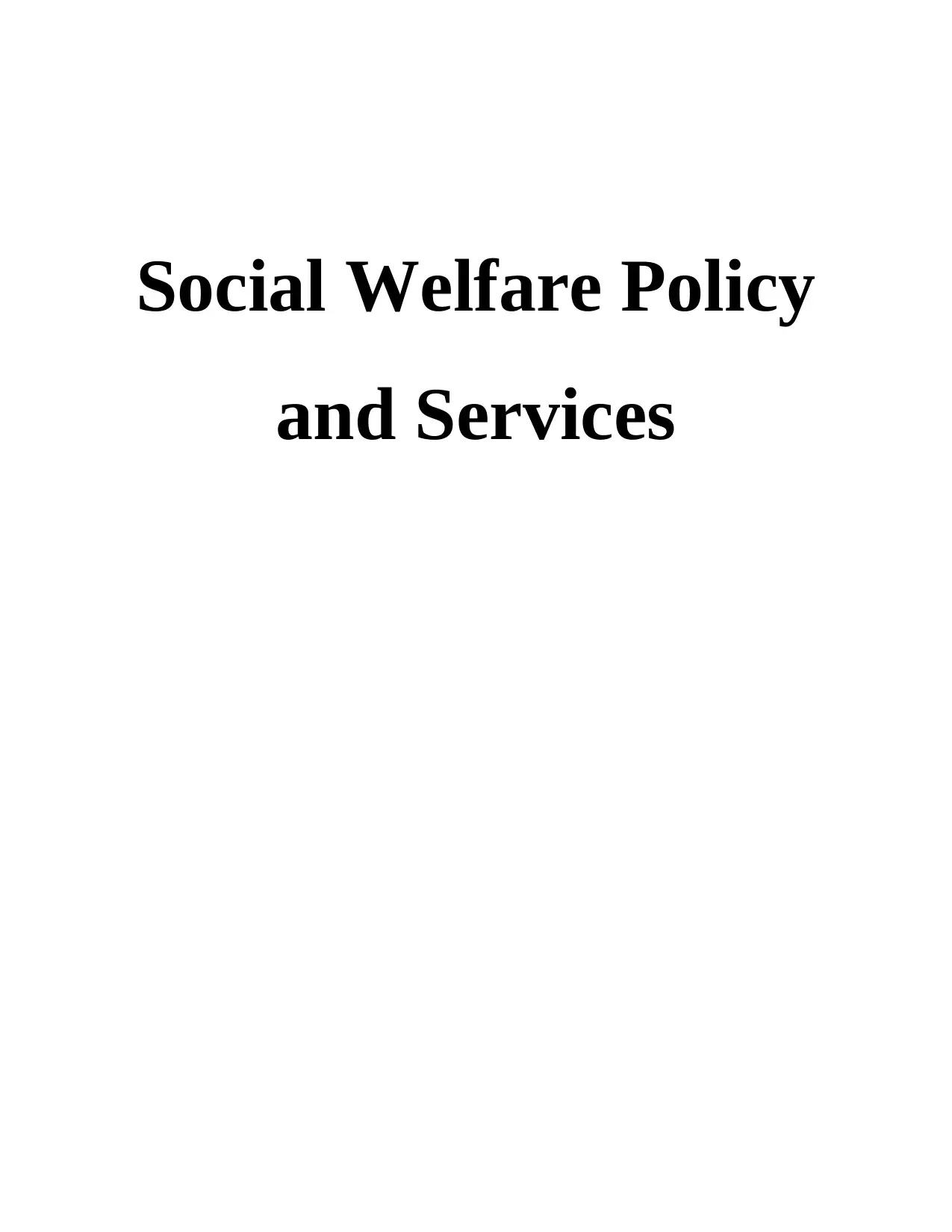
Social Welfare Policy
and Services
and Services
Paraphrase This Document
Need a fresh take? Get an instant paraphrase of this document with our AI Paraphraser
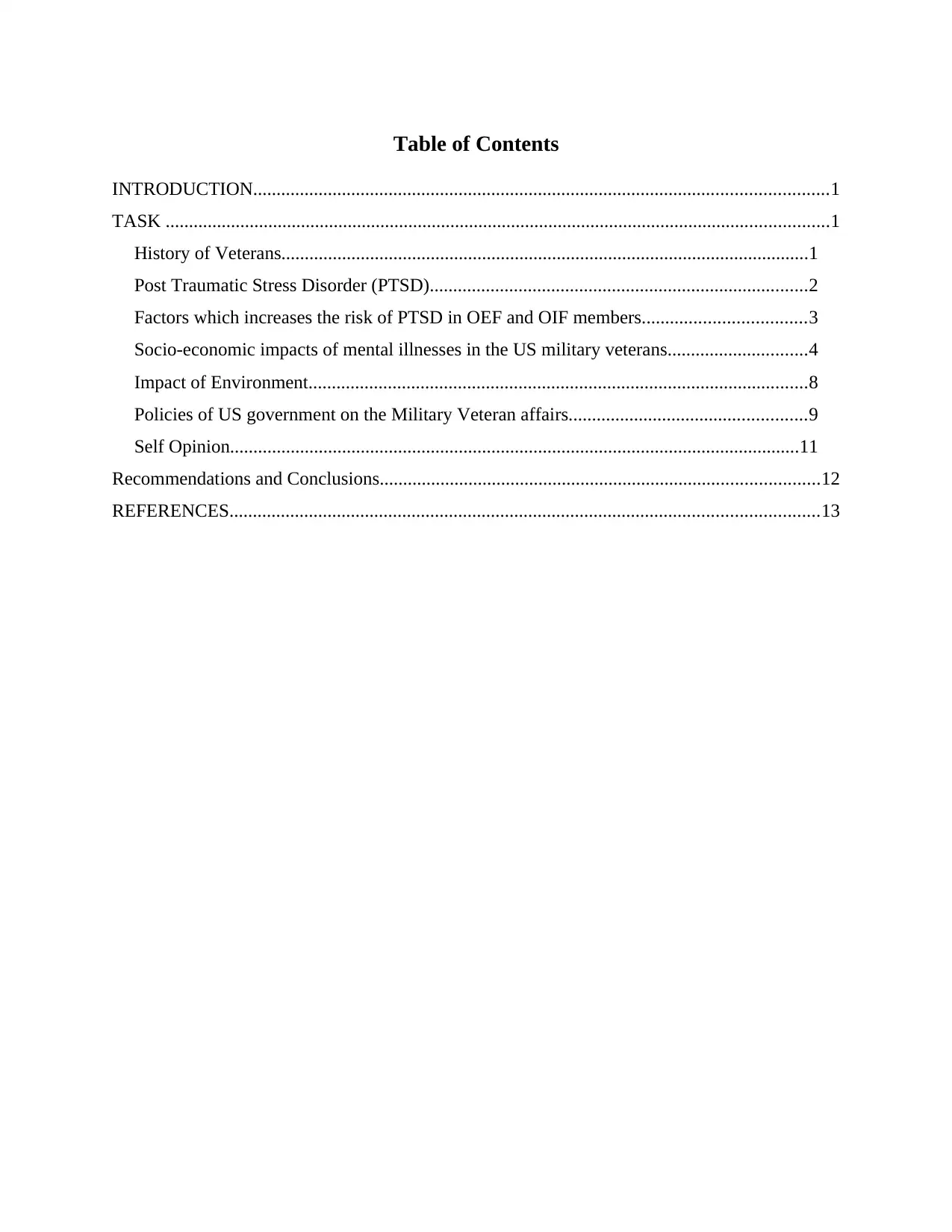
Table of Contents
INTRODUCTION...........................................................................................................................1
TASK ..............................................................................................................................................1
History of Veterans.................................................................................................................1
Post Traumatic Stress Disorder (PTSD).................................................................................2
Factors which increases the risk of PTSD in OEF and OIF members...................................3
Socio-economic impacts of mental illnesses in the US military veterans..............................4
Impact of Environment...........................................................................................................8
Policies of US government on the Military Veteran affairs...................................................9
Self Opinion..........................................................................................................................11
Recommendations and Conclusions..............................................................................................12
REFERENCES..............................................................................................................................13
INTRODUCTION...........................................................................................................................1
TASK ..............................................................................................................................................1
History of Veterans.................................................................................................................1
Post Traumatic Stress Disorder (PTSD).................................................................................2
Factors which increases the risk of PTSD in OEF and OIF members...................................3
Socio-economic impacts of mental illnesses in the US military veterans..............................4
Impact of Environment...........................................................................................................8
Policies of US government on the Military Veteran affairs...................................................9
Self Opinion..........................................................................................................................11
Recommendations and Conclusions..............................................................................................12
REFERENCES..............................................................................................................................13

⊘ This is a preview!⊘
Do you want full access?
Subscribe today to unlock all pages.

Trusted by 1+ million students worldwide
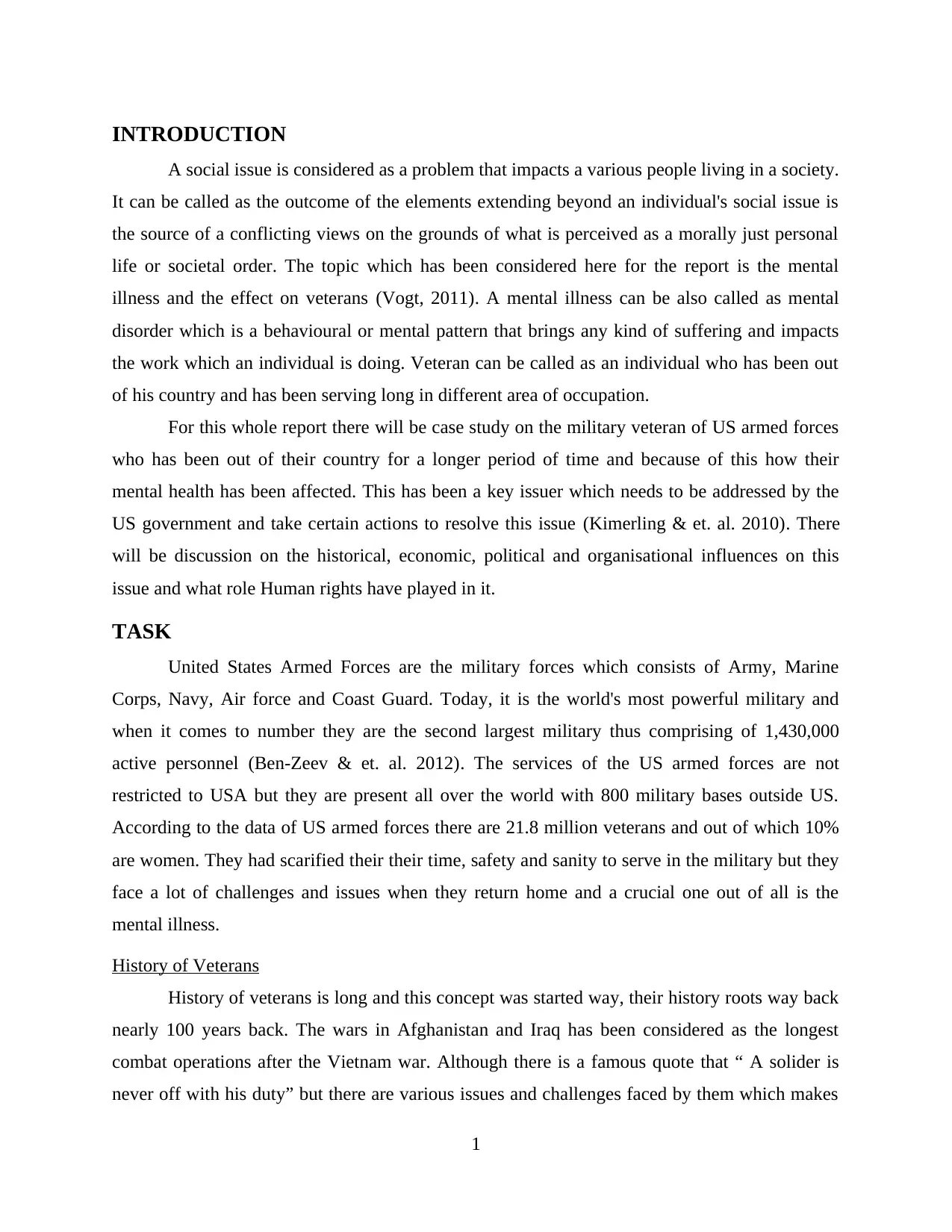
INTRODUCTION
A social issue is considered as a problem that impacts a various people living in a society.
It can be called as the outcome of the elements extending beyond an individual's social issue is
the source of a conflicting views on the grounds of what is perceived as a morally just personal
life or societal order. The topic which has been considered here for the report is the mental
illness and the effect on veterans (Vogt, 2011). A mental illness can be also called as mental
disorder which is a behavioural or mental pattern that brings any kind of suffering and impacts
the work which an individual is doing. Veteran can be called as an individual who has been out
of his country and has been serving long in different area of occupation.
For this whole report there will be case study on the military veteran of US armed forces
who has been out of their country for a longer period of time and because of this how their
mental health has been affected. This has been a key issuer which needs to be addressed by the
US government and take certain actions to resolve this issue (Kimerling & et. al. 2010). There
will be discussion on the historical, economic, political and organisational influences on this
issue and what role Human rights have played in it.
TASK
United States Armed Forces are the military forces which consists of Army, Marine
Corps, Navy, Air force and Coast Guard. Today, it is the world's most powerful military and
when it comes to number they are the second largest military thus comprising of 1,430,000
active personnel (Ben-Zeev & et. al. 2012). The services of the US armed forces are not
restricted to USA but they are present all over the world with 800 military bases outside US.
According to the data of US armed forces there are 21.8 million veterans and out of which 10%
are women. They had scarified their their time, safety and sanity to serve in the military but they
face a lot of challenges and issues when they return home and a crucial one out of all is the
mental illness.
History of Veterans
History of veterans is long and this concept was started way, their history roots way back
nearly 100 years back. The wars in Afghanistan and Iraq has been considered as the longest
combat operations after the Vietnam war. Although there is a famous quote that “ A solider is
never off with his duty” but there are various issues and challenges faced by them which makes
1
A social issue is considered as a problem that impacts a various people living in a society.
It can be called as the outcome of the elements extending beyond an individual's social issue is
the source of a conflicting views on the grounds of what is perceived as a morally just personal
life or societal order. The topic which has been considered here for the report is the mental
illness and the effect on veterans (Vogt, 2011). A mental illness can be also called as mental
disorder which is a behavioural or mental pattern that brings any kind of suffering and impacts
the work which an individual is doing. Veteran can be called as an individual who has been out
of his country and has been serving long in different area of occupation.
For this whole report there will be case study on the military veteran of US armed forces
who has been out of their country for a longer period of time and because of this how their
mental health has been affected. This has been a key issuer which needs to be addressed by the
US government and take certain actions to resolve this issue (Kimerling & et. al. 2010). There
will be discussion on the historical, economic, political and organisational influences on this
issue and what role Human rights have played in it.
TASK
United States Armed Forces are the military forces which consists of Army, Marine
Corps, Navy, Air force and Coast Guard. Today, it is the world's most powerful military and
when it comes to number they are the second largest military thus comprising of 1,430,000
active personnel (Ben-Zeev & et. al. 2012). The services of the US armed forces are not
restricted to USA but they are present all over the world with 800 military bases outside US.
According to the data of US armed forces there are 21.8 million veterans and out of which 10%
are women. They had scarified their their time, safety and sanity to serve in the military but they
face a lot of challenges and issues when they return home and a crucial one out of all is the
mental illness.
History of Veterans
History of veterans is long and this concept was started way, their history roots way back
nearly 100 years back. The wars in Afghanistan and Iraq has been considered as the longest
combat operations after the Vietnam war. Although there is a famous quote that “ A solider is
never off with his duty” but there are various issues and challenges faced by them which makes
1
Paraphrase This Document
Need a fresh take? Get an instant paraphrase of this document with our AI Paraphraser
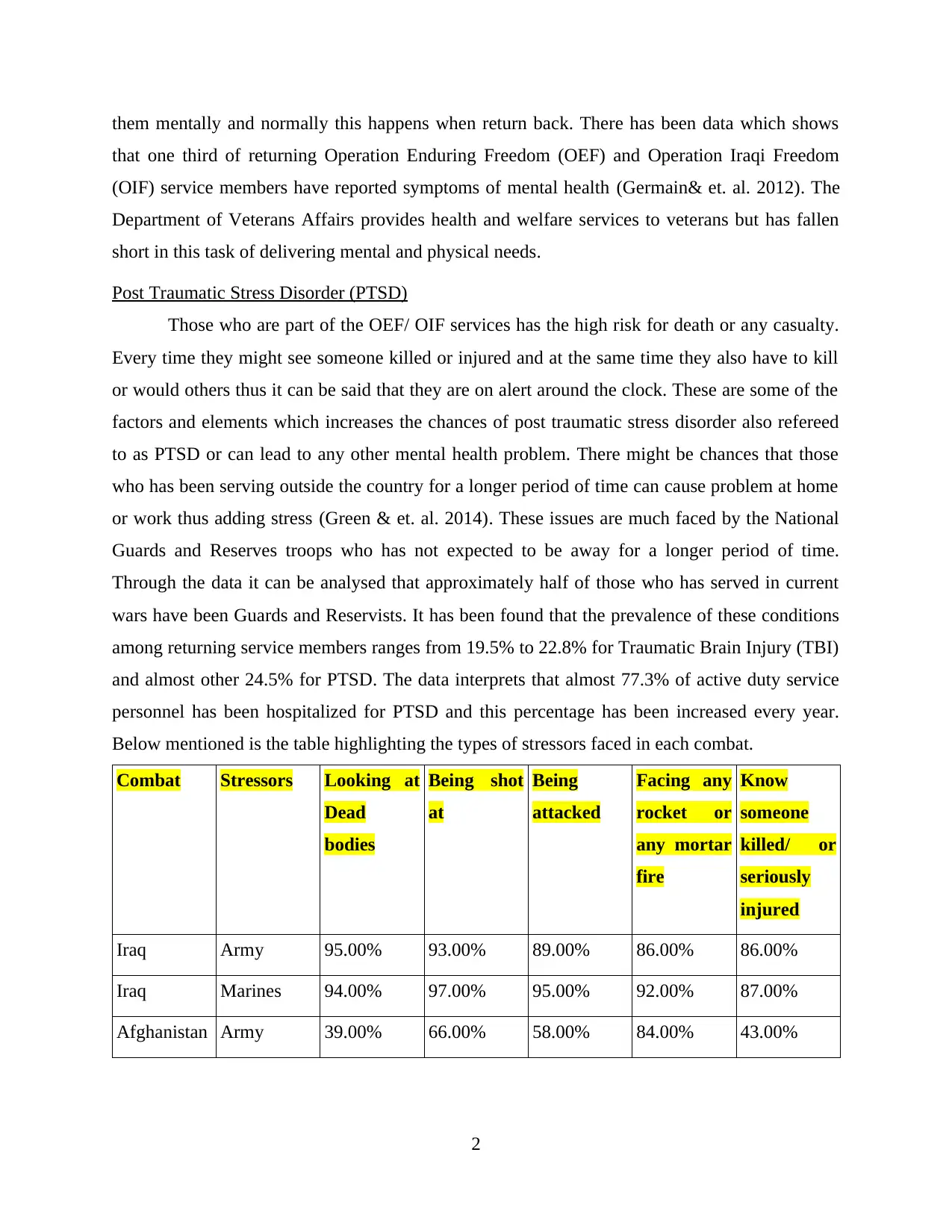
them mentally and normally this happens when return back. There has been data which shows
that one third of returning Operation Enduring Freedom (OEF) and Operation Iraqi Freedom
(OIF) service members have reported symptoms of mental health (Germain& et. al. 2012). The
Department of Veterans Affairs provides health and welfare services to veterans but has fallen
short in this task of delivering mental and physical needs.
Post Traumatic Stress Disorder (PTSD)
Those who are part of the OEF/ OIF services has the high risk for death or any casualty.
Every time they might see someone killed or injured and at the same time they also have to kill
or would others thus it can be said that they are on alert around the clock. These are some of the
factors and elements which increases the chances of post traumatic stress disorder also refereed
to as PTSD or can lead to any other mental health problem. There might be chances that those
who has been serving outside the country for a longer period of time can cause problem at home
or work thus adding stress (Green & et. al. 2014). These issues are much faced by the National
Guards and Reserves troops who has not expected to be away for a longer period of time.
Through the data it can be analysed that approximately half of those who has served in current
wars have been Guards and Reservists. It has been found that the prevalence of these conditions
among returning service members ranges from 19.5% to 22.8% for Traumatic Brain Injury (TBI)
and almost other 24.5% for PTSD. The data interprets that almost 77.3% of active duty service
personnel has been hospitalized for PTSD and this percentage has been increased every year.
Below mentioned is the table highlighting the types of stressors faced in each combat.
Combat Stressors Looking at
Dead
bodies
Being shot
at
Being
attacked
Facing any
rocket or
any mortar
fire
Know
someone
killed/ or
seriously
injured
Iraq Army 95.00% 93.00% 89.00% 86.00% 86.00%
Iraq Marines 94.00% 97.00% 95.00% 92.00% 87.00%
Afghanistan Army 39.00% 66.00% 58.00% 84.00% 43.00%
2
that one third of returning Operation Enduring Freedom (OEF) and Operation Iraqi Freedom
(OIF) service members have reported symptoms of mental health (Germain& et. al. 2012). The
Department of Veterans Affairs provides health and welfare services to veterans but has fallen
short in this task of delivering mental and physical needs.
Post Traumatic Stress Disorder (PTSD)
Those who are part of the OEF/ OIF services has the high risk for death or any casualty.
Every time they might see someone killed or injured and at the same time they also have to kill
or would others thus it can be said that they are on alert around the clock. These are some of the
factors and elements which increases the chances of post traumatic stress disorder also refereed
to as PTSD or can lead to any other mental health problem. There might be chances that those
who has been serving outside the country for a longer period of time can cause problem at home
or work thus adding stress (Green & et. al. 2014). These issues are much faced by the National
Guards and Reserves troops who has not expected to be away for a longer period of time.
Through the data it can be analysed that approximately half of those who has served in current
wars have been Guards and Reservists. It has been found that the prevalence of these conditions
among returning service members ranges from 19.5% to 22.8% for Traumatic Brain Injury (TBI)
and almost other 24.5% for PTSD. The data interprets that almost 77.3% of active duty service
personnel has been hospitalized for PTSD and this percentage has been increased every year.
Below mentioned is the table highlighting the types of stressors faced in each combat.
Combat Stressors Looking at
Dead
bodies
Being shot
at
Being
attacked
Facing any
rocket or
any mortar
fire
Know
someone
killed/ or
seriously
injured
Iraq Army 95.00% 93.00% 89.00% 86.00% 86.00%
Iraq Marines 94.00% 97.00% 95.00% 92.00% 87.00%
Afghanistan Army 39.00% 66.00% 58.00% 84.00% 43.00%
2
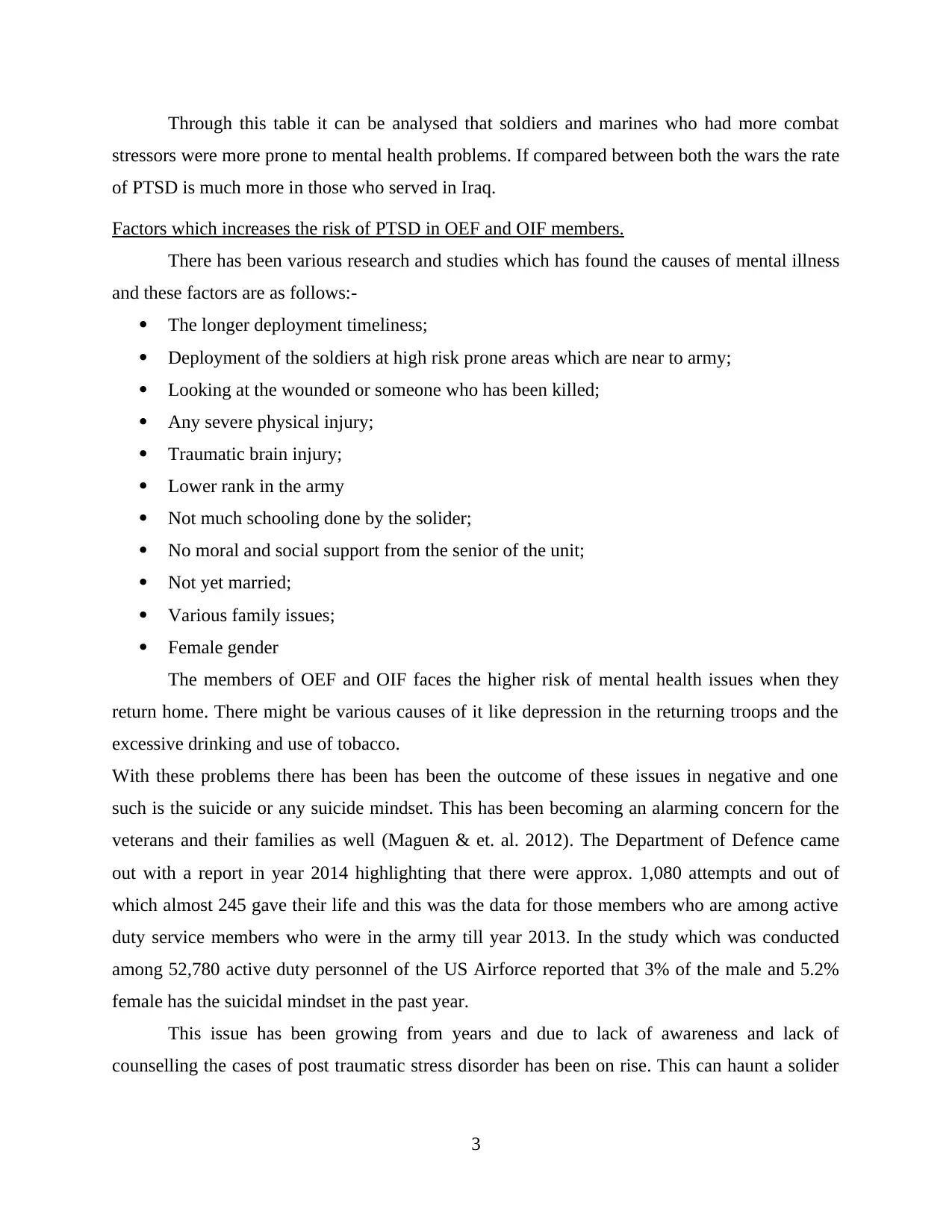
Through this table it can be analysed that soldiers and marines who had more combat
stressors were more prone to mental health problems. If compared between both the wars the rate
of PTSD is much more in those who served in Iraq.
Factors which increases the risk of PTSD in OEF and OIF members.
There has been various research and studies which has found the causes of mental illness
and these factors are as follows:-
The longer deployment timeliness;
Deployment of the soldiers at high risk prone areas which are near to army;
Looking at the wounded or someone who has been killed;
Any severe physical injury;
Traumatic brain injury;
Lower rank in the army
Not much schooling done by the solider;
No moral and social support from the senior of the unit;
Not yet married;
Various family issues;
Female gender
The members of OEF and OIF faces the higher risk of mental health issues when they
return home. There might be various causes of it like depression in the returning troops and the
excessive drinking and use of tobacco.
With these problems there has been has been the outcome of these issues in negative and one
such is the suicide or any suicide mindset. This has been becoming an alarming concern for the
veterans and their families as well (Maguen & et. al. 2012). The Department of Defence came
out with a report in year 2014 highlighting that there were approx. 1,080 attempts and out of
which almost 245 gave their life and this was the data for those members who are among active
duty service members who were in the army till year 2013. In the study which was conducted
among 52,780 active duty personnel of the US Airforce reported that 3% of the male and 5.2%
female has the suicidal mindset in the past year.
This issue has been growing from years and due to lack of awareness and lack of
counselling the cases of post traumatic stress disorder has been on rise. This can haunt a solider
3
stressors were more prone to mental health problems. If compared between both the wars the rate
of PTSD is much more in those who served in Iraq.
Factors which increases the risk of PTSD in OEF and OIF members.
There has been various research and studies which has found the causes of mental illness
and these factors are as follows:-
The longer deployment timeliness;
Deployment of the soldiers at high risk prone areas which are near to army;
Looking at the wounded or someone who has been killed;
Any severe physical injury;
Traumatic brain injury;
Lower rank in the army
Not much schooling done by the solider;
No moral and social support from the senior of the unit;
Not yet married;
Various family issues;
Female gender
The members of OEF and OIF faces the higher risk of mental health issues when they
return home. There might be various causes of it like depression in the returning troops and the
excessive drinking and use of tobacco.
With these problems there has been has been the outcome of these issues in negative and one
such is the suicide or any suicide mindset. This has been becoming an alarming concern for the
veterans and their families as well (Maguen & et. al. 2012). The Department of Defence came
out with a report in year 2014 highlighting that there were approx. 1,080 attempts and out of
which almost 245 gave their life and this was the data for those members who are among active
duty service members who were in the army till year 2013. In the study which was conducted
among 52,780 active duty personnel of the US Airforce reported that 3% of the male and 5.2%
female has the suicidal mindset in the past year.
This issue has been growing from years and due to lack of awareness and lack of
counselling the cases of post traumatic stress disorder has been on rise. This can haunt a solider
3
⊘ This is a preview!⊘
Do you want full access?
Subscribe today to unlock all pages.

Trusted by 1+ million students worldwide
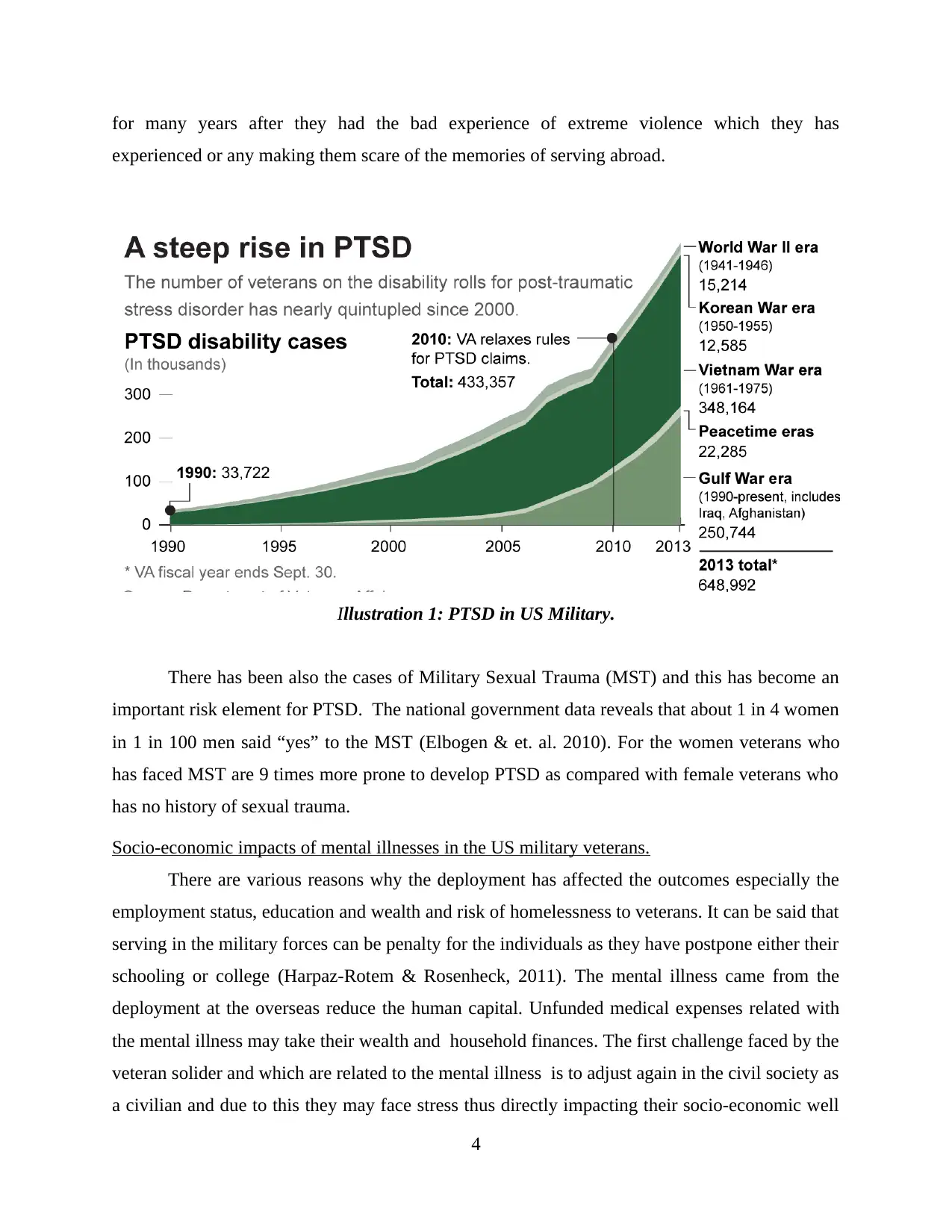
for many years after they had the bad experience of extreme violence which they has
experienced or any making them scare of the memories of serving abroad.
There has been also the cases of Military Sexual Trauma (MST) and this has become an
important risk element for PTSD. The national government data reveals that about 1 in 4 women
in 1 in 100 men said “yes” to the MST (Elbogen & et. al. 2010). For the women veterans who
has faced MST are 9 times more prone to develop PTSD as compared with female veterans who
has no history of sexual trauma.
Socio-economic impacts of mental illnesses in the US military veterans.
There are various reasons why the deployment has affected the outcomes especially the
employment status, education and wealth and risk of homelessness to veterans. It can be said that
serving in the military forces can be penalty for the individuals as they have postpone either their
schooling or college (Harpaz-Rotem & Rosenheck, 2011). The mental illness came from the
deployment at the overseas reduce the human capital. Unfunded medical expenses related with
the mental illness may take their wealth and household finances. The first challenge faced by the
veteran solider and which are related to the mental illness is to adjust again in the civil society as
a civilian and due to this they may face stress thus directly impacting their socio-economic well
4
Illustration 1: PTSD in US Military.
experienced or any making them scare of the memories of serving abroad.
There has been also the cases of Military Sexual Trauma (MST) and this has become an
important risk element for PTSD. The national government data reveals that about 1 in 4 women
in 1 in 100 men said “yes” to the MST (Elbogen & et. al. 2010). For the women veterans who
has faced MST are 9 times more prone to develop PTSD as compared with female veterans who
has no history of sexual trauma.
Socio-economic impacts of mental illnesses in the US military veterans.
There are various reasons why the deployment has affected the outcomes especially the
employment status, education and wealth and risk of homelessness to veterans. It can be said that
serving in the military forces can be penalty for the individuals as they have postpone either their
schooling or college (Harpaz-Rotem & Rosenheck, 2011). The mental illness came from the
deployment at the overseas reduce the human capital. Unfunded medical expenses related with
the mental illness may take their wealth and household finances. The first challenge faced by the
veteran solider and which are related to the mental illness is to adjust again in the civil society as
a civilian and due to this they may face stress thus directly impacting their socio-economic well
4
Illustration 1: PTSD in US Military.
Paraphrase This Document
Need a fresh take? Get an instant paraphrase of this document with our AI Paraphraser
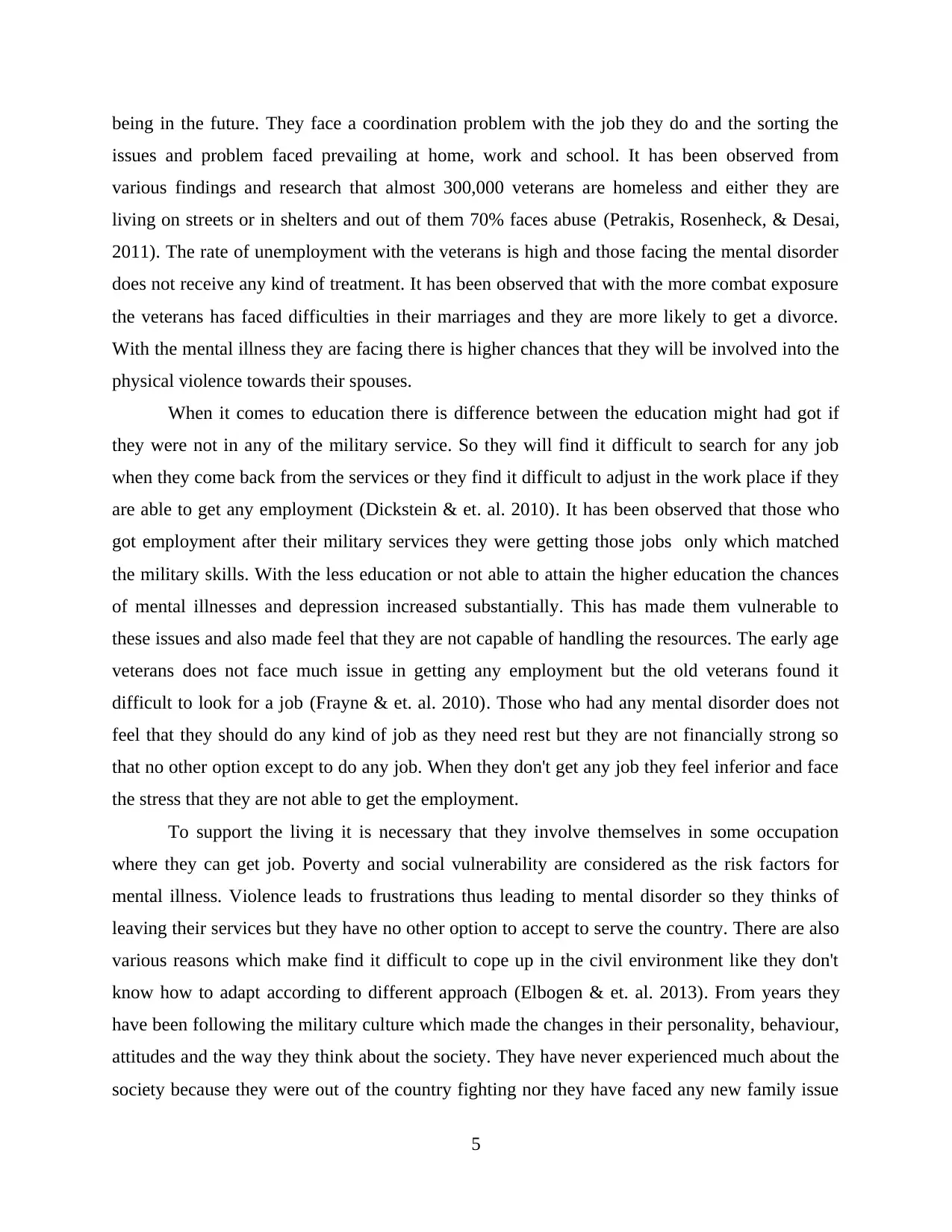
being in the future. They face a coordination problem with the job they do and the sorting the
issues and problem faced prevailing at home, work and school. It has been observed from
various findings and research that almost 300,000 veterans are homeless and either they are
living on streets or in shelters and out of them 70% faces abuse (Petrakis, Rosenheck, & Desai,
2011). The rate of unemployment with the veterans is high and those facing the mental disorder
does not receive any kind of treatment. It has been observed that with the more combat exposure
the veterans has faced difficulties in their marriages and they are more likely to get a divorce.
With the mental illness they are facing there is higher chances that they will be involved into the
physical violence towards their spouses.
When it comes to education there is difference between the education might had got if
they were not in any of the military service. So they will find it difficult to search for any job
when they come back from the services or they find it difficult to adjust in the work place if they
are able to get any employment (Dickstein & et. al. 2010). It has been observed that those who
got employment after their military services they were getting those jobs only which matched
the military skills. With the less education or not able to attain the higher education the chances
of mental illnesses and depression increased substantially. This has made them vulnerable to
these issues and also made feel that they are not capable of handling the resources. The early age
veterans does not face much issue in getting any employment but the old veterans found it
difficult to look for a job (Frayne & et. al. 2010). Those who had any mental disorder does not
feel that they should do any kind of job as they need rest but they are not financially strong so
that no other option except to do any job. When they don't get any job they feel inferior and face
the stress that they are not able to get the employment.
To support the living it is necessary that they involve themselves in some occupation
where they can get job. Poverty and social vulnerability are considered as the risk factors for
mental illness. Violence leads to frustrations thus leading to mental disorder so they thinks of
leaving their services but they have no other option to accept to serve the country. There are also
various reasons which make find it difficult to cope up in the civil environment like they don't
know how to adapt according to different approach (Elbogen & et. al. 2013). From years they
have been following the military culture which made the changes in their personality, behaviour,
attitudes and the way they think about the society. They have never experienced much about the
society because they were out of the country fighting nor they have faced any new family issue
5
issues and problem faced prevailing at home, work and school. It has been observed from
various findings and research that almost 300,000 veterans are homeless and either they are
living on streets or in shelters and out of them 70% faces abuse (Petrakis, Rosenheck, & Desai,
2011). The rate of unemployment with the veterans is high and those facing the mental disorder
does not receive any kind of treatment. It has been observed that with the more combat exposure
the veterans has faced difficulties in their marriages and they are more likely to get a divorce.
With the mental illness they are facing there is higher chances that they will be involved into the
physical violence towards their spouses.
When it comes to education there is difference between the education might had got if
they were not in any of the military service. So they will find it difficult to search for any job
when they come back from the services or they find it difficult to adjust in the work place if they
are able to get any employment (Dickstein & et. al. 2010). It has been observed that those who
got employment after their military services they were getting those jobs only which matched
the military skills. With the less education or not able to attain the higher education the chances
of mental illnesses and depression increased substantially. This has made them vulnerable to
these issues and also made feel that they are not capable of handling the resources. The early age
veterans does not face much issue in getting any employment but the old veterans found it
difficult to look for a job (Frayne & et. al. 2010). Those who had any mental disorder does not
feel that they should do any kind of job as they need rest but they are not financially strong so
that no other option except to do any job. When they don't get any job they feel inferior and face
the stress that they are not able to get the employment.
To support the living it is necessary that they involve themselves in some occupation
where they can get job. Poverty and social vulnerability are considered as the risk factors for
mental illness. Violence leads to frustrations thus leading to mental disorder so they thinks of
leaving their services but they have no other option to accept to serve the country. There are also
various reasons which make find it difficult to cope up in the civil environment like they don't
know how to adapt according to different approach (Elbogen & et. al. 2013). From years they
have been following the military culture which made the changes in their personality, behaviour,
attitudes and the way they think about the society. They have never experienced much about the
society because they were out of the country fighting nor they have faced any new family issue
5
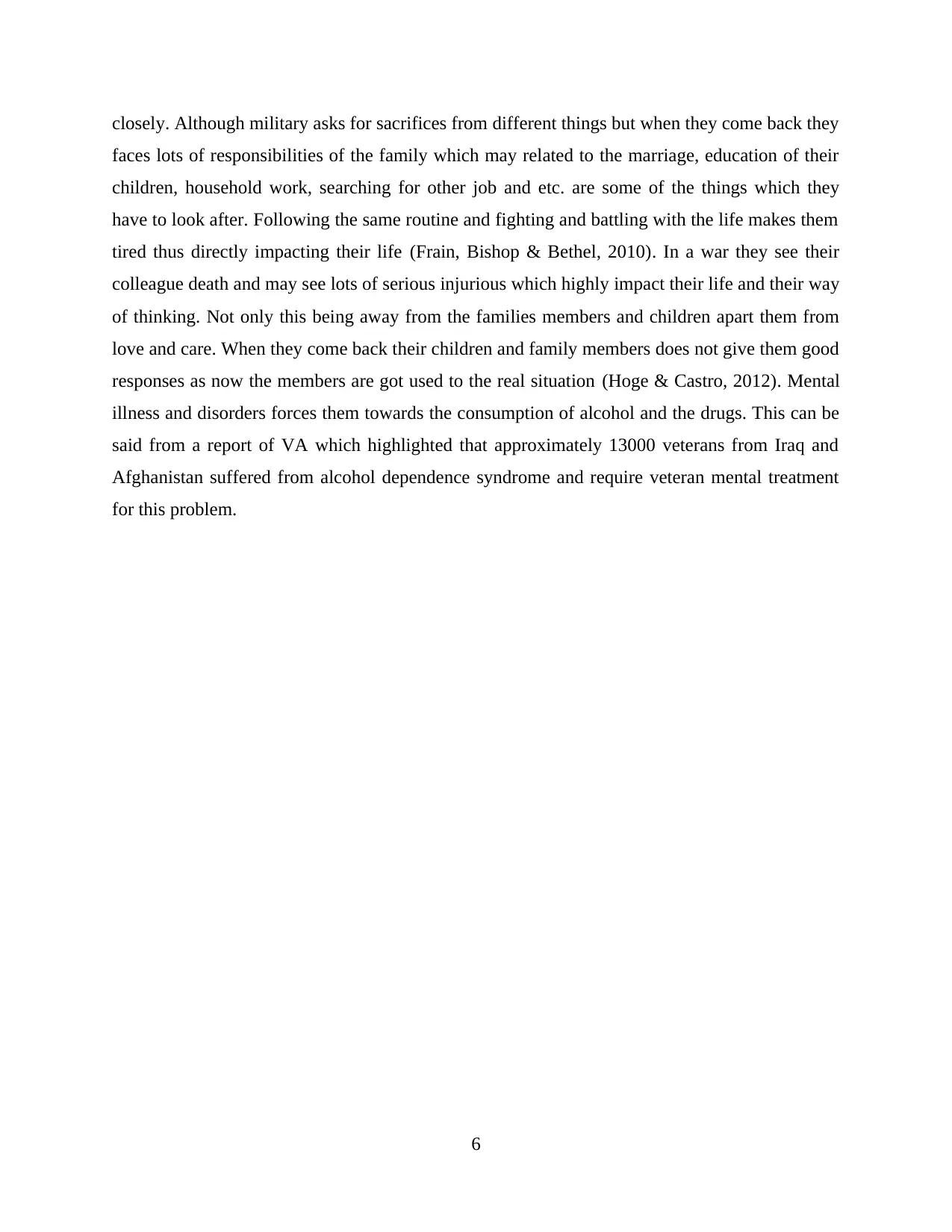
closely. Although military asks for sacrifices from different things but when they come back they
faces lots of responsibilities of the family which may related to the marriage, education of their
children, household work, searching for other job and etc. are some of the things which they
have to look after. Following the same routine and fighting and battling with the life makes them
tired thus directly impacting their life (Frain, Bishop & Bethel, 2010). In a war they see their
colleague death and may see lots of serious injurious which highly impact their life and their way
of thinking. Not only this being away from the families members and children apart them from
love and care. When they come back their children and family members does not give them good
responses as now the members are got used to the real situation (Hoge & Castro, 2012). Mental
illness and disorders forces them towards the consumption of alcohol and the drugs. This can be
said from a report of VA which highlighted that approximately 13000 veterans from Iraq and
Afghanistan suffered from alcohol dependence syndrome and require veteran mental treatment
for this problem.
6
faces lots of responsibilities of the family which may related to the marriage, education of their
children, household work, searching for other job and etc. are some of the things which they
have to look after. Following the same routine and fighting and battling with the life makes them
tired thus directly impacting their life (Frain, Bishop & Bethel, 2010). In a war they see their
colleague death and may see lots of serious injurious which highly impact their life and their way
of thinking. Not only this being away from the families members and children apart them from
love and care. When they come back their children and family members does not give them good
responses as now the members are got used to the real situation (Hoge & Castro, 2012). Mental
illness and disorders forces them towards the consumption of alcohol and the drugs. This can be
said from a report of VA which highlighted that approximately 13000 veterans from Iraq and
Afghanistan suffered from alcohol dependence syndrome and require veteran mental treatment
for this problem.
6
⊘ This is a preview!⊘
Do you want full access?
Subscribe today to unlock all pages.

Trusted by 1+ million students worldwide
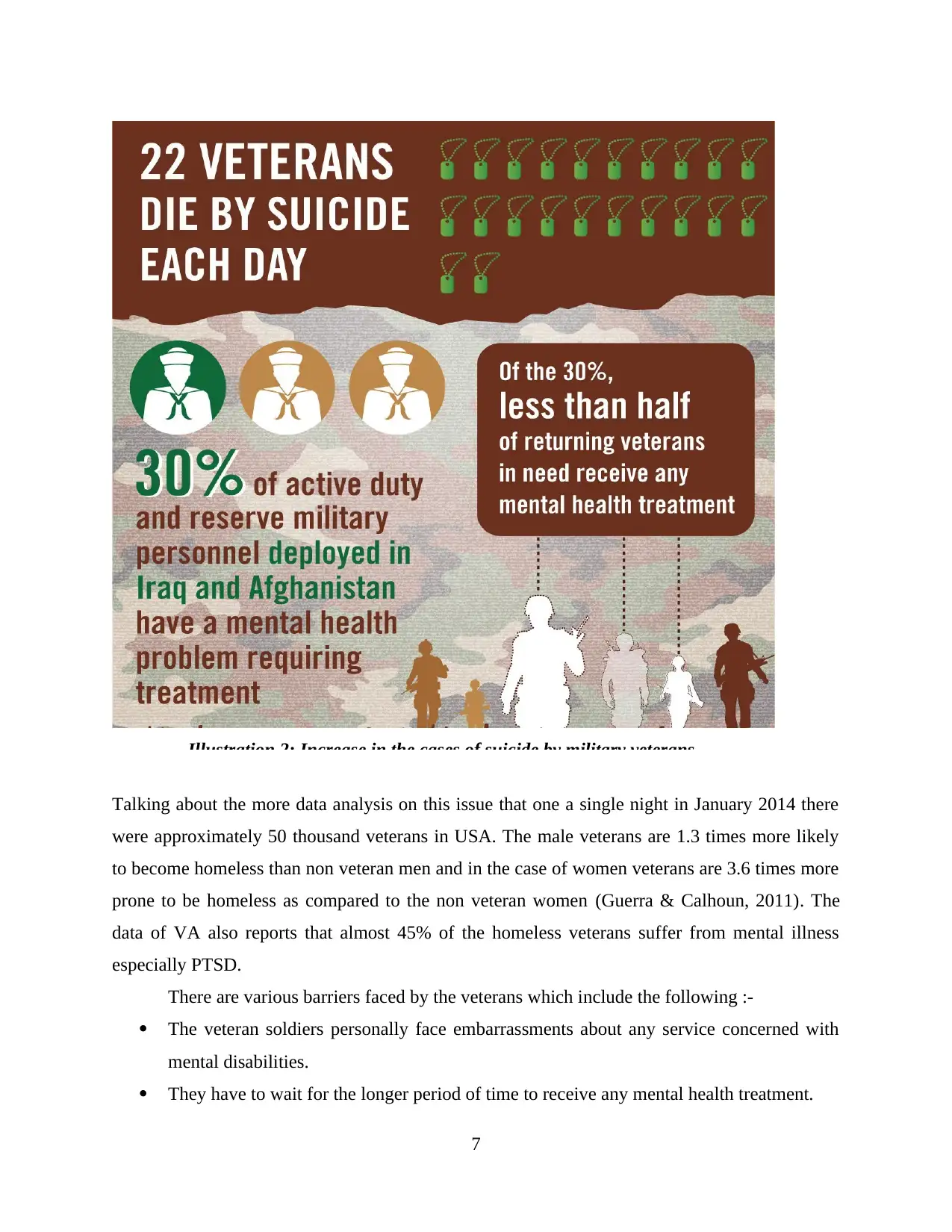
Illustration 2: Increase in the cases of suicide by military veterans.
Talking about the more data analysis on this issue that one a single night in January 2014 there
were approximately 50 thousand veterans in USA. The male veterans are 1.3 times more likely
to become homeless than non veteran men and in the case of women veterans are 3.6 times more
prone to be homeless as compared to the non veteran women (Guerra & Calhoun, 2011). The
data of VA also reports that almost 45% of the homeless veterans suffer from mental illness
especially PTSD.
There are various barriers faced by the veterans which include the following :-
The veteran soldiers personally face embarrassments about any service concerned with
mental disabilities.
They have to wait for the longer period of time to receive any mental health treatment.
7
Talking about the more data analysis on this issue that one a single night in January 2014 there
were approximately 50 thousand veterans in USA. The male veterans are 1.3 times more likely
to become homeless than non veteran men and in the case of women veterans are 3.6 times more
prone to be homeless as compared to the non veteran women (Guerra & Calhoun, 2011). The
data of VA also reports that almost 45% of the homeless veterans suffer from mental illness
especially PTSD.
There are various barriers faced by the veterans which include the following :-
The veteran soldiers personally face embarrassments about any service concerned with
mental disabilities.
They have to wait for the longer period of time to receive any mental health treatment.
7
Paraphrase This Document
Need a fresh take? Get an instant paraphrase of this document with our AI Paraphraser
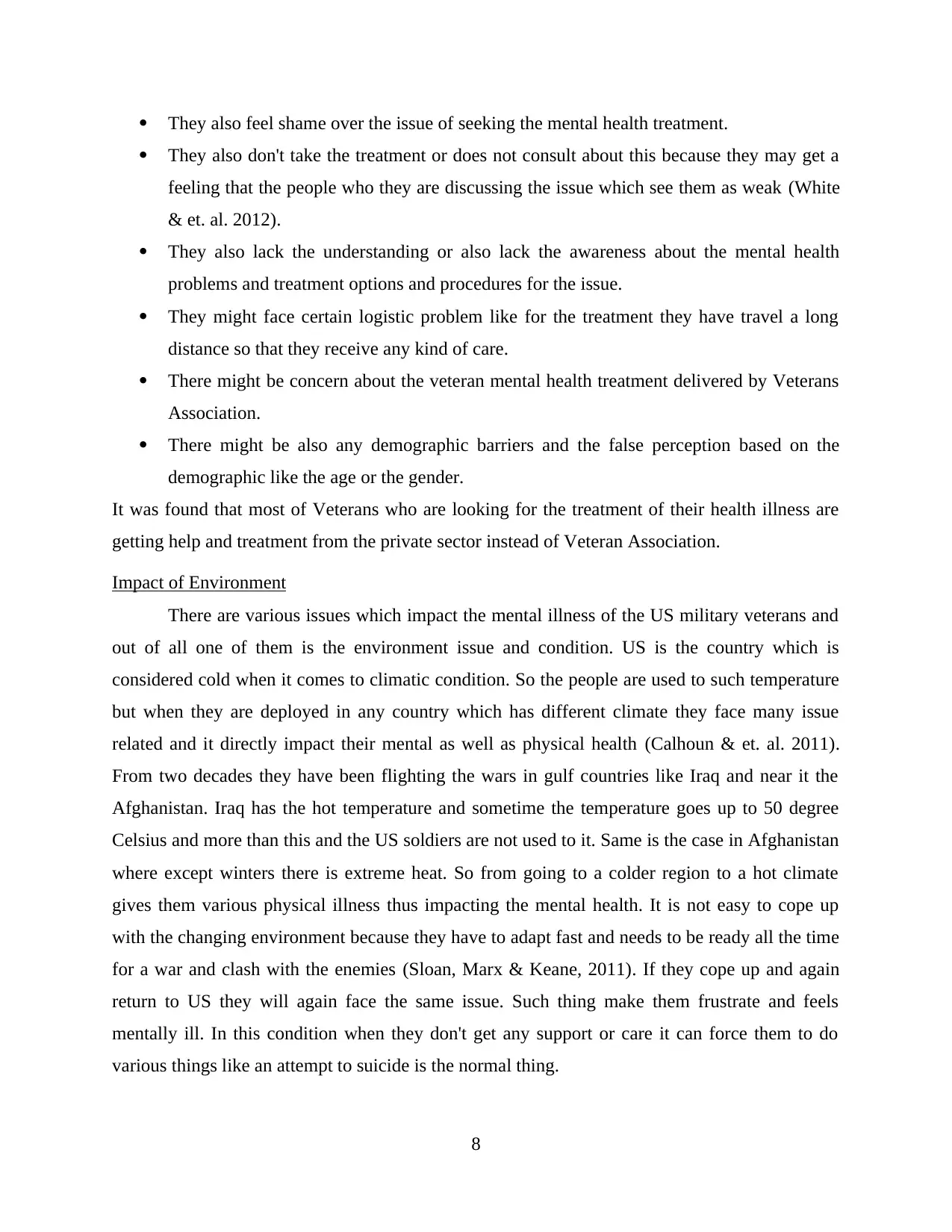
They also feel shame over the issue of seeking the mental health treatment.
They also don't take the treatment or does not consult about this because they may get a
feeling that the people who they are discussing the issue which see them as weak (White
& et. al. 2012).
They also lack the understanding or also lack the awareness about the mental health
problems and treatment options and procedures for the issue.
They might face certain logistic problem like for the treatment they have travel a long
distance so that they receive any kind of care.
There might be concern about the veteran mental health treatment delivered by Veterans
Association.
There might be also any demographic barriers and the false perception based on the
demographic like the age or the gender.
It was found that most of Veterans who are looking for the treatment of their health illness are
getting help and treatment from the private sector instead of Veteran Association.
Impact of Environment
There are various issues which impact the mental illness of the US military veterans and
out of all one of them is the environment issue and condition. US is the country which is
considered cold when it comes to climatic condition. So the people are used to such temperature
but when they are deployed in any country which has different climate they face many issue
related and it directly impact their mental as well as physical health (Calhoun & et. al. 2011).
From two decades they have been flighting the wars in gulf countries like Iraq and near it the
Afghanistan. Iraq has the hot temperature and sometime the temperature goes up to 50 degree
Celsius and more than this and the US soldiers are not used to it. Same is the case in Afghanistan
where except winters there is extreme heat. So from going to a colder region to a hot climate
gives them various physical illness thus impacting the mental health. It is not easy to cope up
with the changing environment because they have to adapt fast and needs to be ready all the time
for a war and clash with the enemies (Sloan, Marx & Keane, 2011). If they cope up and again
return to US they will again face the same issue. Such thing make them frustrate and feels
mentally ill. In this condition when they don't get any support or care it can force them to do
various things like an attempt to suicide is the normal thing.
8
They also don't take the treatment or does not consult about this because they may get a
feeling that the people who they are discussing the issue which see them as weak (White
& et. al. 2012).
They also lack the understanding or also lack the awareness about the mental health
problems and treatment options and procedures for the issue.
They might face certain logistic problem like for the treatment they have travel a long
distance so that they receive any kind of care.
There might be concern about the veteran mental health treatment delivered by Veterans
Association.
There might be also any demographic barriers and the false perception based on the
demographic like the age or the gender.
It was found that most of Veterans who are looking for the treatment of their health illness are
getting help and treatment from the private sector instead of Veteran Association.
Impact of Environment
There are various issues which impact the mental illness of the US military veterans and
out of all one of them is the environment issue and condition. US is the country which is
considered cold when it comes to climatic condition. So the people are used to such temperature
but when they are deployed in any country which has different climate they face many issue
related and it directly impact their mental as well as physical health (Calhoun & et. al. 2011).
From two decades they have been flighting the wars in gulf countries like Iraq and near it the
Afghanistan. Iraq has the hot temperature and sometime the temperature goes up to 50 degree
Celsius and more than this and the US soldiers are not used to it. Same is the case in Afghanistan
where except winters there is extreme heat. So from going to a colder region to a hot climate
gives them various physical illness thus impacting the mental health. It is not easy to cope up
with the changing environment because they have to adapt fast and needs to be ready all the time
for a war and clash with the enemies (Sloan, Marx & Keane, 2011). If they cope up and again
return to US they will again face the same issue. Such thing make them frustrate and feels
mentally ill. In this condition when they don't get any support or care it can force them to do
various things like an attempt to suicide is the normal thing.
8
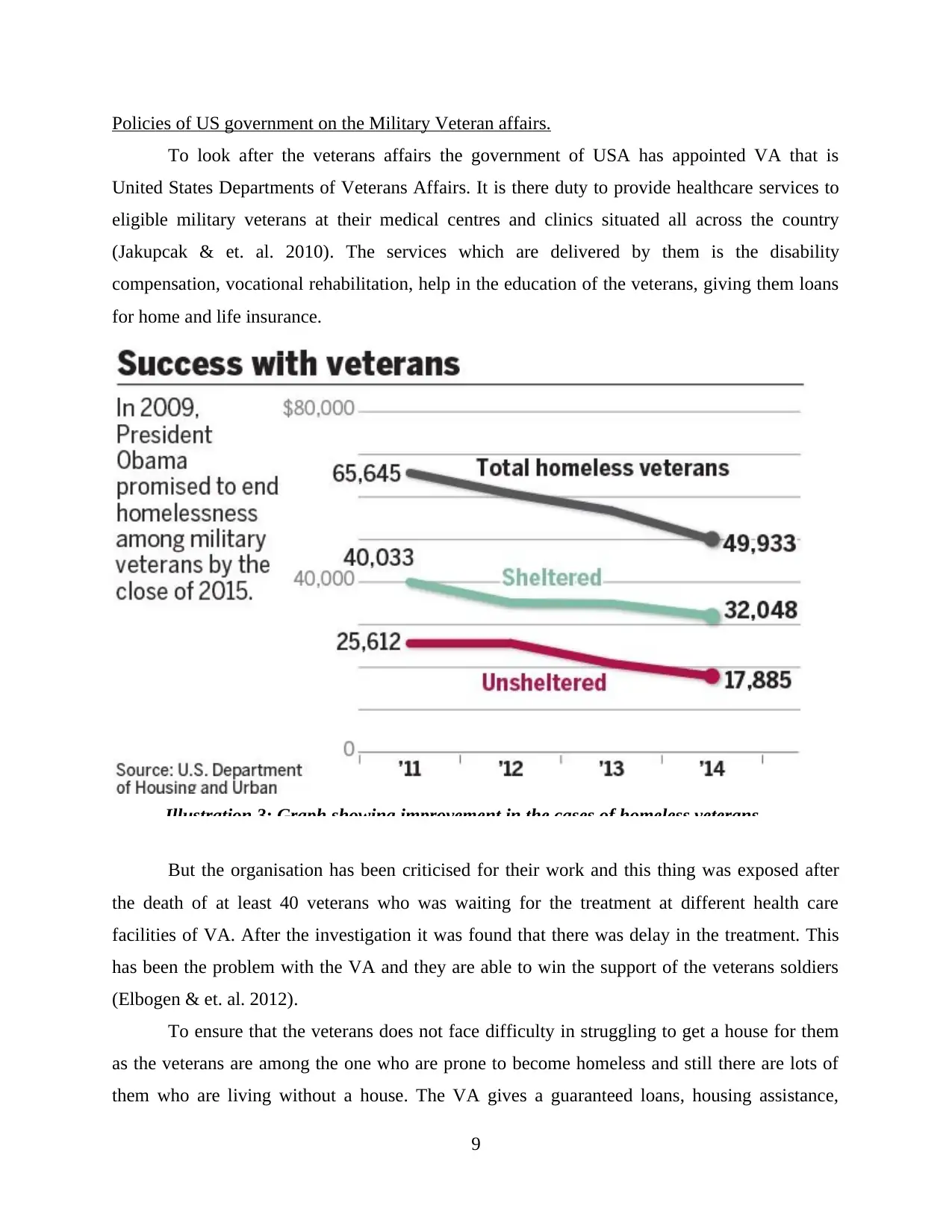
Policies of US government on the Military Veteran affairs.
To look after the veterans affairs the government of USA has appointed VA that is
United States Departments of Veterans Affairs. It is there duty to provide healthcare services to
eligible military veterans at their medical centres and clinics situated all across the country
(Jakupcak & et. al. 2010). The services which are delivered by them is the disability
compensation, vocational rehabilitation, help in the education of the veterans, giving them loans
for home and life insurance.
Illustration 3: Graph showing improvement in the cases of homeless veterans
But the organisation has been criticised for their work and this thing was exposed after
the death of at least 40 veterans who was waiting for the treatment at different health care
facilities of VA. After the investigation it was found that there was delay in the treatment. This
has been the problem with the VA and they are able to win the support of the veterans soldiers
(Elbogen & et. al. 2012).
To ensure that the veterans does not face difficulty in struggling to get a house for them
as the veterans are among the one who are prone to become homeless and still there are lots of
them who are living without a house. The VA gives a guaranteed loans, housing assistance,
9
To look after the veterans affairs the government of USA has appointed VA that is
United States Departments of Veterans Affairs. It is there duty to provide healthcare services to
eligible military veterans at their medical centres and clinics situated all across the country
(Jakupcak & et. al. 2010). The services which are delivered by them is the disability
compensation, vocational rehabilitation, help in the education of the veterans, giving them loans
for home and life insurance.
Illustration 3: Graph showing improvement in the cases of homeless veterans
But the organisation has been criticised for their work and this thing was exposed after
the death of at least 40 veterans who was waiting for the treatment at different health care
facilities of VA. After the investigation it was found that there was delay in the treatment. This
has been the problem with the VA and they are able to win the support of the veterans soldiers
(Elbogen & et. al. 2012).
To ensure that the veterans does not face difficulty in struggling to get a house for them
as the veterans are among the one who are prone to become homeless and still there are lots of
them who are living without a house. The VA gives a guaranteed loans, housing assistance,
9
⊘ This is a preview!⊘
Do you want full access?
Subscribe today to unlock all pages.

Trusted by 1+ million students worldwide
1 out of 17
Related Documents
Your All-in-One AI-Powered Toolkit for Academic Success.
+13062052269
info@desklib.com
Available 24*7 on WhatsApp / Email
![[object Object]](/_next/static/media/star-bottom.7253800d.svg)
Unlock your academic potential
Copyright © 2020–2025 A2Z Services. All Rights Reserved. Developed and managed by ZUCOL.





